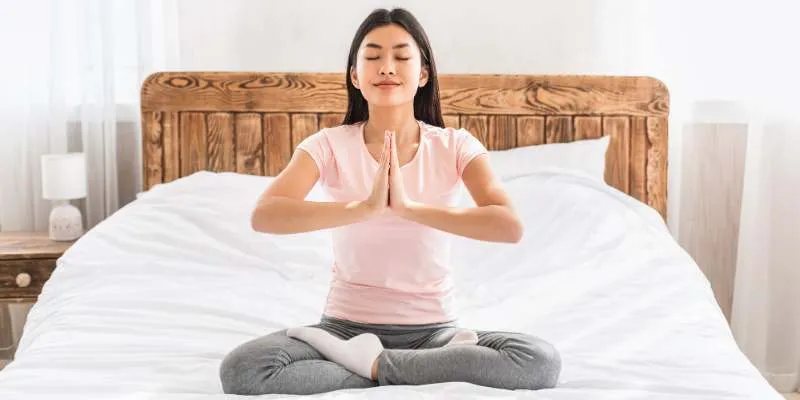How Yoga Nidra Improves Sleep
A powerful relaxation method, Yoga Nidra enhances mental health and sleep quality. Often referred to as yogic slumber, it encourages extreme calmness. This level of consciousness is between waking and sleeping, allowing the body and mind to reset organically.
Stress, anxiety, and hectic lives cause many people to suffer from inadequate sleep. One approach to address these issues is through Yoga Nidra. Regular practice will help you improve your sleep and general well-being. This article explores how Yoga Nidra might enhance your rest and its advantages. Discover how this technique enables you to reach profound relaxation for peaceful sleep and improved health.

What is Yoga Nidra?
Yoga Nidra is a meditative technique that leads you into total relaxation. Often referred to as “yogic sleep,” it fills the void between sleep and consciousness. In this state, the mind is tranquil but conscious. This method first emerged in ancient yoga systems and is now widely used for better sleep and stress relief.
Unlike conventional meditation, Yoga Nidra requires little effort. You lie down, listening to a guided voice. The technique functions by activating the parasympathetic nervous system, helping you relax and reduce stress. Frequent practice can help you quiet your mind and straighten your sleep cycle, making it an easily accessible tool for anyone seeking improved sleep.
How Yoga Nidra Works for Sleep
Yoga Nidra promotes sleep through mental and physical relaxation. It reduces physical stress and overthinking by guiding you into a peaceful state similar to deep slumber. During a session, your brain waves slow down, replicating the restorative power of sleep, allowing you to relax consciously, unlike conventional sleep.
Additionally, Yoga Nidra lowers cortisol levels, the stress hormone that can disrupt sleep cycles. By reducing stress, it facilitates falling asleep. Regular application of this method enhances sleep patterns, allowing your body to relax and rejuvenate naturally. Yoga Nidra is an essential, quick fix for regular restlessness or insomnia.
Understanding The Science Behind Yoga Nidra and Its Effect on Sleep
By activating the parasympathetic nervous system—which controls relaxation and recovery—Yoga Nidra helps improve sleep. In this state, the body can heal, mend, and regenerate itself. Yoga Nidra has been found to help lower cortisol levels, the hormone connected with stress. Lowering stress hormones enables the body and mind to relax, fostering an atmosphere conducive to sleep.
Yoga Nidra also aids in the regulation of sleep cycles in the brain. It helps the body transition from the sympathetic nervous system’s fight-or-flight response to the parasympathetic system’s rest-and-digest response, essential for achieving continuous sleep. Yoga Nidra also encourages the release of melatonin, a hormone controlling the sleep-wake cycle, thereby improving the body’s ability to fall and stay asleep naturally.
Benefits of Yoga Nidra for Sleep Quality
One of the main benefits of Yoga Nidra for sleep is its ability to help you fall asleep faster. The practice induces a calm mood, making the transition from wakefulness to sleep more natural. Practitioners can unwind and fall asleep instead of lying in bed worried or tense. Additionally, Yoga Nidra reduces the frequency of overnight awakenings.
Encouraging relaxation preserves a regular sleep cycle, allowing the body to go through deeper sleep phases, including REM sleep. Cognitive abilities, including memory, learning, and emotional control, depend on REM sleep. By reducing nightmares or vivid dreams, which could disturb rest, Yoga Nidra enhances sleep quality. People often find they sleep more peacefully and wake up feeling rejuvenated.

How to Perform Yoga Nidra for Better Sleep
Establishing a regular practice is crucial if you want to maximize Yoga Nidra for better sleep. Here’s how to start:
1. Find a Quiet Space: Select a calm, cozy area without disturbances. Lie on your back, either on a mat or a bed. 2. Set an Intention (Sankalpa): Begin with a positive affirmation or intention, such as achieving tranquility, reducing stress, or improving sleep. 3. Body Scan: Progressively bring awareness to various areas of your body, starting from the toes upward. This relaxation method releases tension. 4. Breath Awareness: Focus on your deep, steady breaths. Inhale deeply, hold briefly, then exhale gently. 5. Visualization: Imagine a serene, soothing landscape, such as a forest or beach, to help you unwind. 6. End with Affirmation: Finish your session with a positive statement supporting your goal of quiet, deep sleep.
Over time, practicing Yoga Nidra, especially before bed, can greatly enhance sleep quality. Even a twenty-minute session can leave you feeling calm and ready for sleep.
Yoga Nidra as a Natural Remedy for Insomnia
For millions worldwide suffering from insomnia, Yoga Nidra offers a natural cure. Insomnia can result from stress, anxiety, or an overactive mind. Yoga Nidra helps reduce mental chatter and promote relaxation, addressing these root causes. By enabling deep relaxation, Yoga Nidra alleviates insomnia symptoms.
This practice triggers the body’s natural relaxation response, aiding in falling asleep and staying asleep. Regular Yoga Nidra practice retrains the body’s response to stress over time, reducing the likelihood of sleep problems. Besides enhancing sleep, Yoga Nidra improves overall mental health by promoting self-awareness and mindfulness, enabling better control over insomnia-inducing factors.
Tips for Incorporating Yoga Nidra into Your Routine
Starting Yoga Nidra is simple if done correctly. Use these tips to incorporate it into your lifestyle:
1. Set a Schedule: Practice Yoga Nidra at the same time daily, ideally before bed. 2. Create a Relaxing Environment: Use low lighting and soothing lavender scents. 3. Start with Short Sessions: Begin with 15-minute exercises, gradually increasing the duration. 4. Be Consistent: Regular practice enhances its effectiveness for better sleep.
Developing Yoga Nidra into a habit will help you appreciate its advantages. It is an easy, affordable approach to improving sleep quality.
Conclusion
Yoga Nidra is a natural and effective way to enhance sleep quality. By promoting relaxation, reducing stress, and helping you disconnect from daily concerns, it creates the perfect setting for peaceful sleep. Regular practice allows you to experience deeper, restful sleep and wake up feeling rejuvenated. Whether your sleep is disturbed or you want to enhance it, Yoga Nidra can provide a restful night’s sleep. Start incorporating this powerful technique into your routine for long-lasting results.











